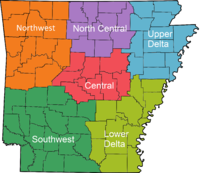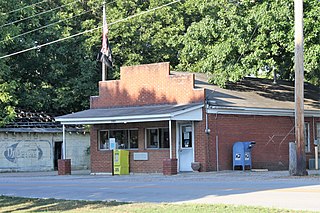Background
A proposed school consolidation came as a result of education reform measures spearheaded by the Arkansas Education Association (AEA), [3] which was prompted by a 1921 study done by the Arkansas Legislature that criticized conditions at various public schools. [4]
In the 1926–1927 school year, Arkansas had 4,711 school districts, with 3,106 of them each operating a school for white students that only employed a single teacher. Various laws affecting taxation and state and county governance reduced the number of school districts, including a 1927 law that allowed counties, upon voter approval, to modify boundaries of existing school districts or to create new school districts, Act 156, and a 1929 law that allowed voters in a county to vote in favor of consolidating multiple school districts into one, Act 149. [3] However, in 1931 a law was passed stating that in order for a school district to consolidate, the voters in each district must approve. [5]
In the 1932–1933 school year, Arkansas had 3,086 school districts, with 1,990 of them each operating a school for white students that only employed a single teacher. Calvin R. Ledbetter Jr. of the University of Arkansas at Little Rock stated that the Great Depression caused a drop in government revenues and frustrated school consolidation. [3]
In 1946 there were 1,900 school districts educating 406,199 students, with a typical county having an average of 25 school districts. That year 76,000 students lived in a district which had a high school that had not been accredited since there were insufficient students, and about 100,000 students lived in districts that did not operate high schools. Ledbetter stated that about 40% of the K-12 students in Arkansas were realistically not able to go beyond junior high school. [6] That year there was a petition for an Act 1 which would have forced school districts with under 350 students to form "county rural school districts", created as a result of a lack of teachers due to several being drafted into the military, moving out of state, or moving on to defense jobs during World War II. [5] This proposal would mean Arkansas would have about 400 school districts. [6] The two newspapers distributed throughout the entire state of Arkansas supported this. [7] However newspapers did not print advertisements supporting the passage of the act nor did they print the opposite. [8] At the time people advocating for or against political causes bought space to print advertisements for them in newspapers. [9] Voters rejected this with 68,510 opposing (50.47%), with the Arkansas Democrat stating that they were heavily in smaller counties and especially in the state's north, and with 67,209 (49.52%) supporting, credited by the Democrat as being heavily in larger counties. Ledbetter characterized the voting margin as "a fraction". [7]
In 1948 over 60% of Arkansas voters passed Act 1, [8] which was to force any school district with under 300 students to consolidate. No lawsuits resulted from the passage. There were no advertisements supporting the referendum in newspapers, [9] nor any against. [8] Governor of Arkansas Benjamin Travis Laney stated opposition without stating his reasoning. [8] It was favored by Sid McMath, who became the Democratic Party candidate for governor. The two major statewide newspapers also supported this act. [10] Some rural voters were afraid their children would have too long of a commute to school and therefore opposed it. [8]
From 1948 to 1949, the number of school districts fell from 1,600 to 423, [11] and in 1964 this was down to 412. [12] In 1966 there was a referendum to require school districts with under 400 students to consolidate. The Arkansas Gazette supported the measure but Governor of Arkansas Orval Faubus stated opposition to it. Additionally Winthrop Rockefeller and Jim Johnson, two candidates for the 1966 election of the governor of Arkansas, also stated opposition. 321,733 people voted against it, making up 73.59%. 115,452 people voted for it, making up 26.41%. Ledbetter characterized the result as "a landslide". [9]
There were 370 school districts in 1983. After the Arkansas State Board of Education created rules for the minimum level of standards a school district must provide in its educational program that year, the number of school districts declined further, [13] with there being 311 in 1996, and then, as of 1998, 310. [14]
Since 2003, two major components in Arkansas public school districts must exist:
- Each school district must have a high school, and
- Each school district must have 350 students.
The current consolidation policy that mandates operational changes for all districts with fewer than 350 students is the Public Education Reorganization Act—Act 60 of the Second Extraordinary Session of 2003. [15]
Geographical school districts in Arkansas are generally independent from city or county jurisdiction.
Arkansas school district boundaries are not always aligned with county or city boundaries; a district can occupy several counties and cities, while a single city (especially larger ones such as Little Rock, Fort Smith, or Jonesboro) may be split between several districts. Almost all Arkansas school districts use the title "School District", or "Public Schools".
All districts come under the jurisdiction of the Arkansas Department of Education (ADE). Extracurricular activities come under the jurisdiction of the Arkansas Activities Association.
In 1996 the average Arkansas school district had 1,468 students. [14]



